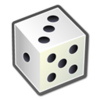Pairwise error probability
| Part of a series on statistics |
| Probability theory |
|---|
 |
Pairwise error probability is the error probability that for a transmitted signal ([math]\displaystyle{ X }[/math]) its corresponding but distorted version ([math]\displaystyle{ \widehat{X} }[/math]) will be received. This type of probability is called ″pair-wise error probability″ because the probability exists with a pair of signal vectors in a signal constellation.[1] It's mainly used in communication systems.[1]
Expansion of the definition
In general, the received signal is a distorted version of the transmitted signal. Thus, we introduce the symbol error probability, which is the probability [math]\displaystyle{ P(e) }[/math] that the demodulator will make a wrong estimation [math]\displaystyle{ (\widehat{X}) }[/math] of the transmitted symbol [math]\displaystyle{ (X) }[/math] based on the received symbol, which is defined as follows:
- [math]\displaystyle{ P(e) \triangleq \frac{1}{M} \sum_{x} \mathbb{P} (X \neq \widehat{X}|X) }[/math]
where M is the size of signal constellation.
The pairwise error probability [math]\displaystyle{ P(X \to \widehat{X}) }[/math] is defined as the probability that, when [math]\displaystyle{ X }[/math] is transmitted, [math]\displaystyle{ \widehat{X} }[/math] is received.
- [math]\displaystyle{ P(e|X) }[/math] can be expressed as the probability that at least one [math]\displaystyle{ \widehat{X} \neq X }[/math] is closer than [math]\displaystyle{ X }[/math] to [math]\displaystyle{ Y }[/math].
Using the upper bound to the probability of a union of events, it can be written:
- [math]\displaystyle{ P(e|X)\le\sum_{\widehat{X}\neq X} P(X \to \widehat{X}) }[/math]
Finally:
- [math]\displaystyle{ P(e) = \tfrac{1}{M} \sum_{X \in S} P(e|X) \leq \tfrac{1}{M} \sum_{X \in S}\sum_{\widehat{X}\neq X} P(X \to \widehat{X}) }[/math]
Closed form computation
For the simple case of the additive white Gaussian noise (AWGN) channel:
- [math]\displaystyle{ Y = X + Z, Z_i \sim \mathcal{N}(0,\tfrac{N_0}{2} I_n) \,\! }[/math]
The PEP can be computed in closed form as follows:
- [math]\displaystyle{ \begin{align} P(X \to \widehat{X}) & = \mathbb{P}(||Y-\widehat{X}||^2 \lt ||Y-X||^2|X) \\ & = \mathbb{P}(||(X+Z)-\widehat{X}||^2 \lt ||(X+Z)-X||^2) \\ & = \mathbb{P}(||(X - \widehat{X})+Z||^2 \lt ||Z||^2) \\ & = \mathbb{P}(||X- \widehat{X}||^2 +||Z||^2 +2(Z,X-\widehat{X})\lt ||Z||^2) \\ & = \mathbb{P}(2(Z,X-\widehat{X})\lt -||X- \widehat{X}||^2)\\ & = \mathbb{P}((Z,X-\widehat{X})\lt -||X- \widehat{X}||^2/2) \end{align} }[/math]
[math]\displaystyle{ (Z,X-\widehat{X}) }[/math] is a Gaussian random variable with mean 0 and variance [math]\displaystyle{ N_0||X- \widehat{X}||^2/2 }[/math].
For a zero mean, variance [math]\displaystyle{ \sigma^2=1 }[/math] Gaussian random variable:
- [math]\displaystyle{ P(X \gt x) = Q(x) = \frac{1}{\sqrt{2\pi}} \int_{x}^{+\infty} e^-\tfrac{t^2}{2}dt }[/math]
Hence,
- [math]\displaystyle{ \begin{align} P(X \to \widehat{X}) & =Q \bigg(\tfrac{\tfrac{||X- \widehat{X}||^2}{2}}{\sqrt{\tfrac{N_0||X- \widehat{X}||^2}{2}}}\bigg)= Q \bigg(\tfrac{||X- \widehat{X}||^2}{2}.\sqrt{\tfrac{2}{N_0||X- \widehat{X}||^2}}\bigg) \\ & = Q \bigg(\tfrac{||X- \widehat{X}||}{\sqrt{2N_0}}\bigg) \end{align} }[/math]
See also
References
- ↑ 1.0 1.1 Stüber, Gordon L. (8 September 2011). Principles of mobile communication (3rd ed.). New York: Springer. pp. 281. ISBN 978-1461403647.
Further reading
- Prasad, 5th IEEE International Symposium on Personal, Indoor, and Mobile Radio Communications (PIMRC '94) The Hague, the Netherlands, September 18–22, 1994; ICCC Regional Meeting on Wireless Computer Networks (WCN), the Hague, the Netherlands, September 21–23, 1994; edited by Jos H. Weber, Jens C. Arnbak, and Ramjee (1994). Wireless networks : catching the mobile future : proceedings. Amsterdam: IOS Press. pp. 564–575. ISBN 9051991932.
- Simon, Marvin K.; Alouini, Mohamed-Slim (2005). Digital Communication over Fading Channels (2. ed.). Hoboken: John Wiley & Sons. ISBN 0471715239.
 |

